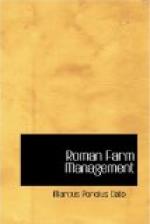It remains to speak elsewhere of unyoked cattle, like the flocks, but if there are meadows on the farm and the owner keeps no live stock, it is the business of a good farmer after he has sold his hay to graze and feed another’s cattle on his land.
Of farming implements
XXII. Concerning the instruments of agriculture which are called mute, in which are included baskets, wine jars and such things, this may be said: Those utensils which can be produced on the farm or made by the servants should never be bought, among which are what ever may be made out of osiers or other wood of the country, such as hampers, fruit baskets, threshing sledges, mauls and mattocks, or what ever is made out of the fibre plants like hemp, flax, rushes, palm leaves and nettles, namely: rope, twine and mats. Those implements which cannot be manufactured on the farm should be bought more with reference to their utility than their appearance that they may not diminish your profit by useless expense, a result which may be best secured by buying where the things you need may be found at once of good quality, near at hand and cheap. The requirement of the kind and number of such implements is measured by the extent of the farm because the further your boundaries lie apart the more work there is to do.”
“In this connection,” put in Stolo, “given the size of the farm, Cato recommends with respect to implements as follows: he who cultivates 240 jugera in olives should have five sets of oil making implements, which he enumerates severally, such as the copper utensils, including kettles, pots, ewers with three spouts, etc.; the implements made out of wood and iron, including three large wagons, six ploughs with their shares, four manure carriers, etc. So of the iron tools, what they are and how many are needed, he speaks in great detail, as eight iron pitch forks, as many hoes and half as many shovels, etc.
“In like manner he lays down another formula of implements for a vineyard, viz.: if you cultivate 100 jugera you should have three sets of implements for the wine press and also covered storage vats of a capacity of eight hundred cullei, as well as twenty harvesting hampers for grapes and as many for corn, and other things in like proportion.
“Other writers advise a smaller quantity of such conveniences, but I believe Cato prescribed so great a capacity in order that one might not be compelled to sell his wine every year, for old wine sells better than new, and the same quality sells better at one time than another. Cato writes further in great detail of the kind and number of iron tools which are required for a vineyard, such as the falx or pruning hook, spades, hoes. So also several of these instruments are of many varieties, as for instance the falx, of which this author says that there must be provided forty of the kind suitable for use in a vineyard, five for cutting rushes, three for pruning trees and ten for cutting briers.”




